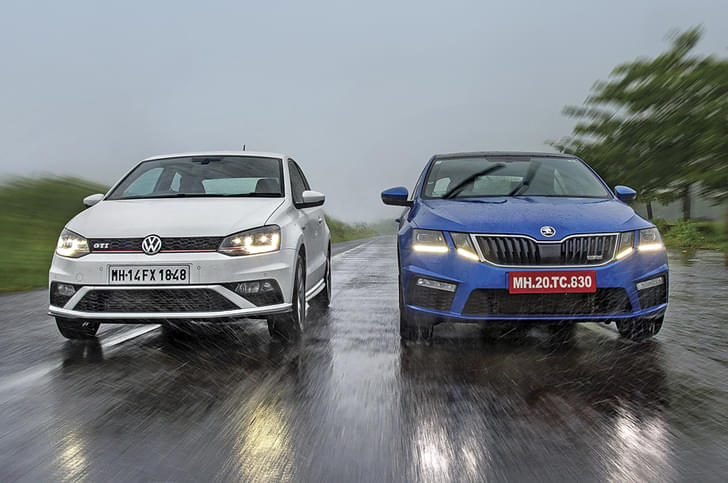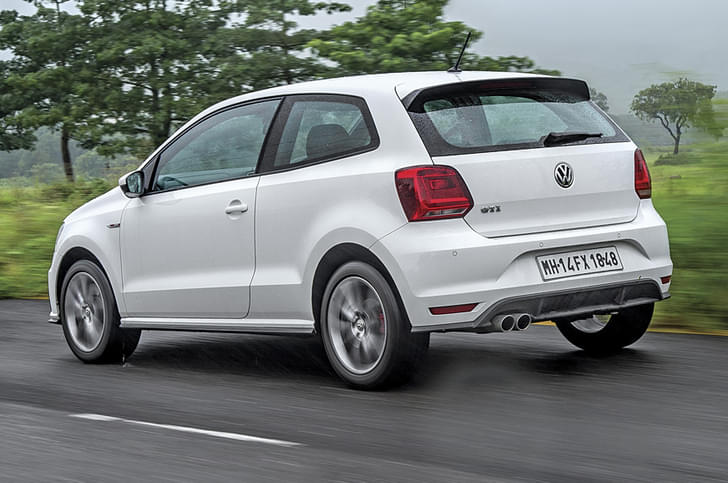4.2-4.4m-long SUVs have been the rage for a while now, and there’s lots of reasons why. There’s the typical SUV draws of high ground clearance, an elevated seating position and, of course, street cred, and then there’s the matter that these midsize SUVs also seem right-sized for India. They portray that much wanted big-car image, yet don’t feel unwieldy on our congested roads like the larger models from the SUV universe.
For carmakers, the midsize SUV segment is the segment to crack. And that’s telling in our line-up, because, of the six models featured here, three were launched over just the past year. To give a brief of the contenders, the MG Astor is the newest and is relying on comfort and tech to wow buyers. The Volkswagen Taigun and Skoda Kushaq are the VW Group’s new entries in the segment, and the promise is of European engineering at wallet-friendly prices. Hyundai’s original Creta ruled the segment since launch in 2015, and this second-gen model that’s been on sale since 2020 builds on the very successful formula. The Creta’s cousin from Kia, the big selling Seltos, offers a different flavour with the same ingredients. And last but not least, we have the Nissan Kicks that’s the oldest model here, if you go by launch chronology, though it’s fresh from an update of its own with new engines and gearboxes for the BS6 era. We’d have loved to have included the Kicks’ cousin and OG midsized SUV Renault’s Duster too, but it’s just bowed after a near-10 year production run. The S-Cross, though dimensionally similar, is a bit too crossover and not SUV enough to mix in this company.
It’s the Kia Seltos and Hyundai Creta, in that order, with the widest range of engine-gearbox options and are the only ones with diesel powertrains too. However, in consideration here are the most powerful turbo-petrol and automatic gearbox-equipped versions of each of the contenders. We’ll be relying on facts, figures and feel to tell you all about them, and what each one stands out for.
| MG Astor vs Rivals: Specifications | ||||||
|---|---|---|---|---|---|---|
| MG Astor 1.3 Turbo AT Sharp (O) | Volkswagen Taigun 1.5 TSI DSG GT Plus | Skoda Kushaq 1.5 TSI DSG Style (6 airbag) | Hyundai Creta 1.4 Turbo GDi DCT SX(O) | Kia Seltos 1.4 T-GDi GTX+ DCT | Nissan Kicks 1.3 Turbo CVT XV Premium | |
| Length | 4323 | 4221 | 4225 | 4300 | 4315 | 4384 |
| Width | 1809 | 1760 | 1760 | 1790 | 1800 | 1813 |
| Height | 1650mm | 1612mm | 1612mm | 1635mm | 1645mm | 1669mm |
| Wheelbase | 2585mm | 2651mm | 2651mm | 2610mm | 2610mm | 2673mm |
| Ground Clearance (Unladen) | 185mm (estimated) | 188mm | 188mm | 190mm | 190mm | 210mm |
| Kerb Weight | 1355kg | 1310kg | 1305kg | 1323kg | 1321kg | 1352kg |
| Engine | 3 cyls, 1349cc, turbo-petrol | 4 cyls, 1498cc, turbo-petrol | 4 cyls, 1498cc, turbo-petrol | 4 cyls, 1353cc, turbo-petrol | 4 cyls, 1353cc, turbo-petrol | 4 cyls, 1330cc, turbo-petrol |
| Power | 140hp at 5600rpm | 150hp at 5000-6000rpm | 150hp at 5000-6000rpm | 140hp at 6000rpm | 140hp at 6000rpm | 156hp at 5500rpm |
| Torque | 220Nm at 3600rpm | 250Nm at 1600-3500rpm | 250Nm at 1600-3500rpm | 242Nm at 1500-3200rpm | 242Nm at 1500-3200rpm | 254Nm at 1600rpm |
| Gearbox | 6-speed auto | 7-speed dual-clutch auto | 7-speed dual-clutch auto | 7-speed dual-clutch auto | 7-speed dual-clutch auto | 7 step CVT |
| Fuel Economy (ARAI) | - | 17.88kpl | 17.70kpl | 16.8kpl | 16.5kpl | - |
| Tank Capacity | 45 litres | 50 litres | 50 litres | 50 litres | 50 litres | 50 litres |
| Boot | 359 litres (international spec) | 385 litres | 385 litres | 433 litres | 433 litres | 400 litres |
| Tyres | 215/55 R17 | 205/55 R17 | 205/55 R17 | 215/60 R17 | 215/60 R17 | 215/60 R17 |
Heart of the matter
A quick specification comparison will reveal that the Astor’s 140hp and 220Nm, 1.3-litre turbo-petrol engine is the only three-cylinder unit here, and the MG’s also the only one to use a torque converter gearbox. The Volkswagen Taigun and Skoda Kushaq share their 150hp and 250Nm, 1.5-litre, four-cylinder, turbo-petrol engine and 7-speed DSG dual-clutch transmission, and it’s a similar story with the Hyundai Creta and Kia Seltos that use the same hardware of 140hp and 242Nm, 1.4-litre turbo-petrol engines and 7-speed dual-clutch transmissions. The Nissan Kicks is the only one with a CVT, while its 1.3-litre turbo-petrol engine has bragging rights with the most power and torque of 156hp and 254Nm, respectively. SUVs these may be, but they all channel their power to the front wheels only. That’s that for the on-paper comparison. What’s each one like to drive?
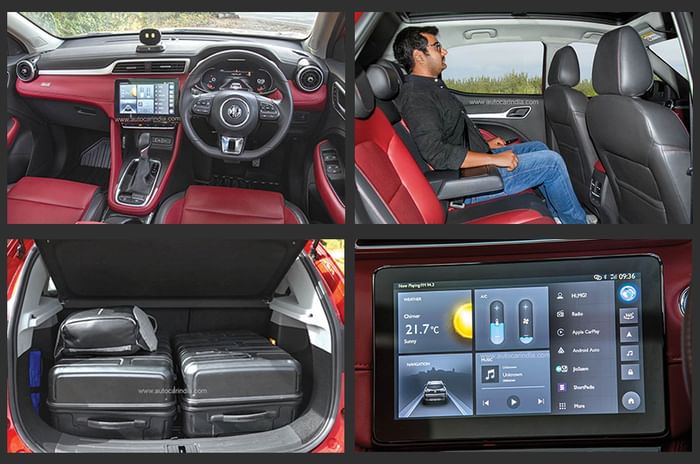
The MG Astor comes across as the most laid-back of the six. Its engine has an easy-going nature and while there is a hint of hesitation at low speeds, it’s masked well by the 6-speed torque converter gearbox. You’ll also appreciate the engine for how quiet it runs in average driving scenarios. You will hear a thrum at higher revs, but this is not an engine that will tempt you to wind it anyway. It doesn’t rev as hard or quick as the others, and even the gearbox isn’t lightning quick. The numbers will tell you the Astor is brisk, but it doesn’t feel like it’s in a hurry to deliver its power.
It’s a similar story on the Nissan Kicks and that’s despite its class-best power figures. The Kicks is peppiest off the line, helped in no small measure by the CVT, and it is thrilling for a moment, but doesn’t quite offer the sustained rush of power you’d expect. Performance is appreciable nonetheless, and the gearbox also scores for smoothness, and gets through its duties without too much of that rubber band effect. It’s also nice and responsive to tugs at the gear lever that allow you to go up and down the pre-defined steps.
The Creta and Seltos feel more wholesome in the area of performance. There’s a likeable flexibility to their 1.4 turbo-petrol engines, with ready access to power from low revs leading into a juicy mid-range. Both models also offer the option to fine-tune the experience with three drive modes that alter engine, gearbox and steering characteristics, and Sport mode does dial things up, allowing the engine to rev quite keenly to 6,000rpm. Paddleshifters also add to driver engagement. The Hyundai and Kia’s 7-speed DCTs are also slick, if just down on speed to the VW Group cars’ DSG units. Good engine refinement rounds off the pleasing experience.
There’s almost nothing between the Creta and Seltos in flat-out performance, with both registering impressive sub-10sec 0-100kph times. However, driving the Korean duo back to back did reveal slight differences in how they deliver their power. The Seltos feels that little bit more urgent under hard acceleration, though it’s actually slower in kickdown acceleration; something which could be attributed to different engine and gearbox calibrations.

If turbocharged petrol engines equal forceful performance for you, it’s the Taigun and Kushaq that’ll put the widest smiles on your face. The VW Group’s 1.5 TSI Evo engine is a gem. Sure, it isn’t as responsive as Hyundai’s unit at lower revs (the DSG gearbox also feels restrictive on hard launches) but the party starts in the mid-range. There’s a strong surge from 2,500rpm that continues till well past 6,000rpm. Adding to the excitement is the DSG gearbox that’s quick to run through the gears and is very responsive to inputs at the paddleshifters.
The feeling of performance is reflected in the timings as well. The Taigun and Kushaq are the quickest of the six. However, it’s the Taigun that tops the charts with an 8.89sec 0-100kph time and best kickdown numbers too. Performance should have been similar since the Volkswagen and Skoda powertrains are identical, and so our guess is that the Taigun’s better aerodynamics could have played a role for it being quicker. What’s worth bringing in is that you hear more of the Taigun and Kushaq’s engines in the cabins, though that’s more likely a function of the sound deadening than of engine refinement itself.
MG Astor vs Rivals: Performance MG Astor 1.3 Turbo AT Sharp (O) Volkswagen Taigun 1.5 TSI DSG GT Plus Skoda Kushaq 1.5 TSI DSG Style (6 airbag) Hyundai Creta 1.4 Turbo GDi DCT SX(O) Kia Seltos 1.4 T-GDi GTX+ DCT Nissan Kicks 1.3 Turbo CVT XV Premium PERFORMANCE Acceleration (from rest) Acceleration (from rest) Acceleration (from rest) Acceleration (from rest) Acceleration (from rest) Acceleration (from rest) 0.-20kph 1.13s 1.45s 1.47s 1.54s 1.52s 1.30s 0-40kph 2.50s 2.62s 2.78s 2.71s 2.86s 2.67s 0-60kph 4.39s 4.41s 4.55s 4.87s 4.67s 4.62s 0-80kph 6.82s 6.48s 6.86s 7.16s 6.96s 7.04s 0-100kph 10.23s 8.89s 9.54s 9.81s 9.72s 10.22s 0-120kph 14.08s 12.23s 13.26s 13.61s 13.65s 14.37s 0-140kph 19.74s 16.43s 18.09s 18.69s 18.96s 20.28s 20-80kph (kickdown) 5.78s 5.14s 5.66s 5.55s 5.71s 5.62s 40-100kph (kickdown) 7.60s 6.08s 6.75s 6.66s 7.36s 7.44s BRAKING DISTANCE 80-0kph 26.24m 25.23m 25.35m 27.57m 27.55m 26.17m NOISE LEVEL Idle 39.3 38.8 38.3 39 40.3 42 AC at 2 45.8 44.1 45.1 49.1 49 48.1 AC at Mid 49.2 51.6 53.2 54.6 55.5 50.8 AC at High 66.2 65.7 67.1 63.3 62.6 65.1 At 50kph 59 58.3 59 58.4 58.9 57.8 At 80kph 61.7 60 62.5 67.5 62.6 63.3 Max revs 68.4 73 72.5 71.5 72 72.3
Handle with flair
All six models are similar in their suspension set-ups, with McPherson struts up front and non-independent, twist beam arrangements at the back. 17-inch rims are the norm, too, so how different can they be in the area of ride and handling? The short answer is, very.
It’s the Astor with the cushiest low-speed ride, and the overall good noise insulation only adds to the feeling of comfort. An easy-to-twirl steering also makes the MG well suited to city environs. Uniquely, the Astor gets three steering modes that alter the level of assistance. You can feel the added heft as you move from Urban to Normal to Dynamic, but even at its sportiest, the steering doesn’t give you a good sense of connect with the car. At high speeds, you’ll note a dead zone at the straight ahead position, followed by an unnervingly sharp response with just a few degrees of lock. The softly set-up suspension also brings with it lots of body roll in the bends.
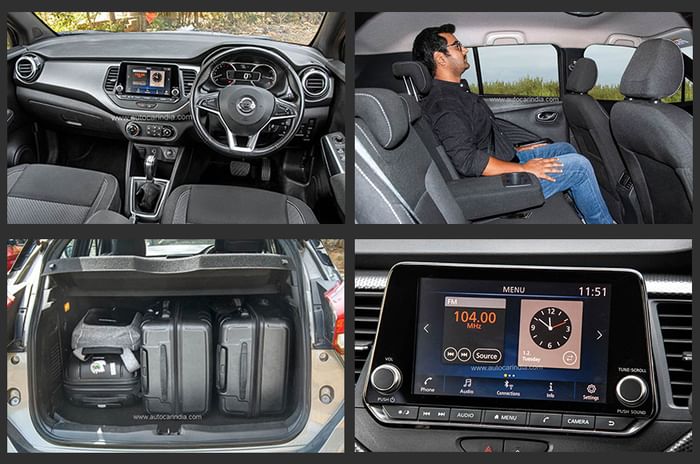
The Nissan Kicks has its own hits and misses. The confidence with which the Kicks despatches poorly paved surfaces at all speeds establishes it as the toughest and most SUV-like in this bunch. The Nissan also corners flat and it all adds up to make this a model well suited to adventurous cross-country journeys. Trouble is, the Kicks isn’t quite the city-friendly choice. There’s an ever-present firmness to the ride, the old-school hydraulic assisted steering requires considerable effort to twirl and there’s kickback at the steering wheel too on potholes.
The Creta and Seltos are not as tough as the Kicks and actually feel the ‘loosest’ over bad patches of road taken at speed. In most other scenarios, though, you’ll like how the Hyundai and Kia go about their business. Both SUVs’ steerings are light in town and weigh up sufficiently at high speeds, both models change direction with ease and both also feel well tied down on fast stretches. However, there are differences. The Creta that’s slightly softer in its suspension set-up rounds off the bumps that little bit better than Seltos. You will feel more of the road in the Kia, but its marginally firmer set-up also grants it slightly keener handling.
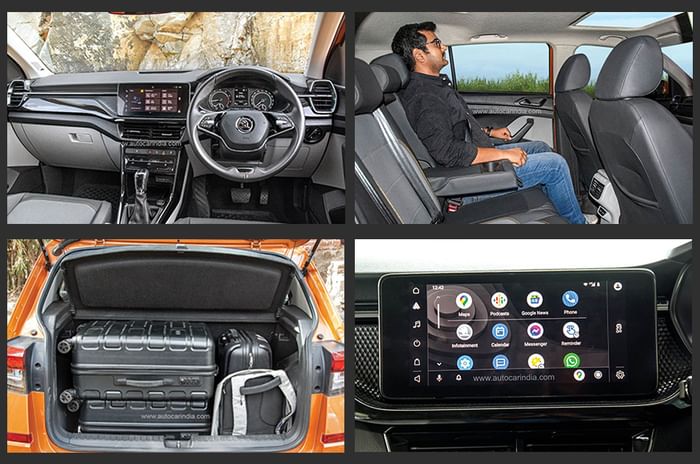
On fun factor, it’s the Taigun and Kushaq that top the list. Both models corner with poise, there’s great bite at the front end and, though a touch light, their steerings are the most rewarding in feel too. Unlike the Astor that tells you to take it easy, the Taigun and Kushaq egg you on to drive harder. On long highway drives too, you’ll like how sure-footed the VW and Skoda SUVs feel and how they shake off bad patches of road. At lower speeds, there’s an acceptable level of firmness in the suspension, but what isn’t acceptable are the creaks from the beading at the doors on potholes. Dealers are offering to replace the beading as a permanent fix.
Playing safe
We’ve talked acceleration numbers already and it’s only fitting that we lead into the safety section with a word on braking performance. While all the SUVs stop well, it was, ironically, the models without rear disc brakes, namely the Taigun, Kushaq and Kicks that stopped in the shortest distance from 80kph.
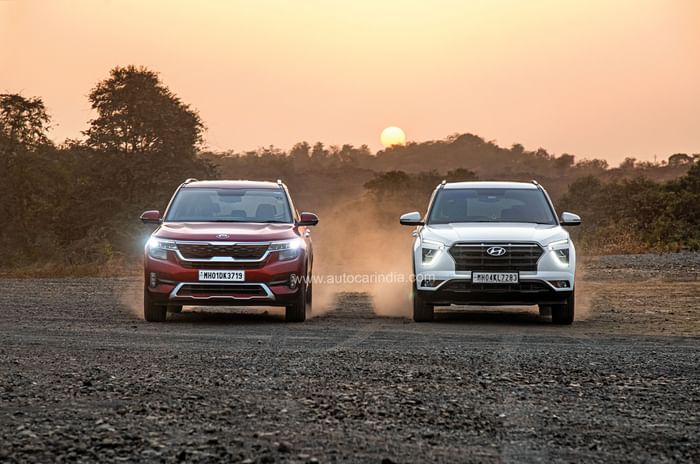
In terms of safety kit, all models featured here get ABS, ESC, hill start assist and child seat mounts. The Astor, Taigun, Kushaq, Creta and Seltos get six airbags in fully-loaded form, while the Kicks Turbo CVT that’s only sold in mid-spec trim makes do with just two. The Seltos is the only one with front parking sensors and also features very handy Lane Watch cameras that relay footage of blind spots onto the instrument cluster. In active safety features, though, it’s the Astor that packs in a whole lot more with its radar and camera-based ADAS or Advanced Driver Assistance Systems. The Astor’s adaptive cruise control, forward collision warning and automatic emergency braking can be life savers, and are particularly essential in our distracted times. We weren’t quite at ease with the lane keep assist that steers the car to keep within the lane, but did find lane departure warning and blind spot assist very useful. The MG is also the only one with hill descent control.
All models comply with latest Indian crash test norms, but only the Seltos has been crash tested by Global NCAP that rated it a middle-of-the-road three stars on adult occupant protection.
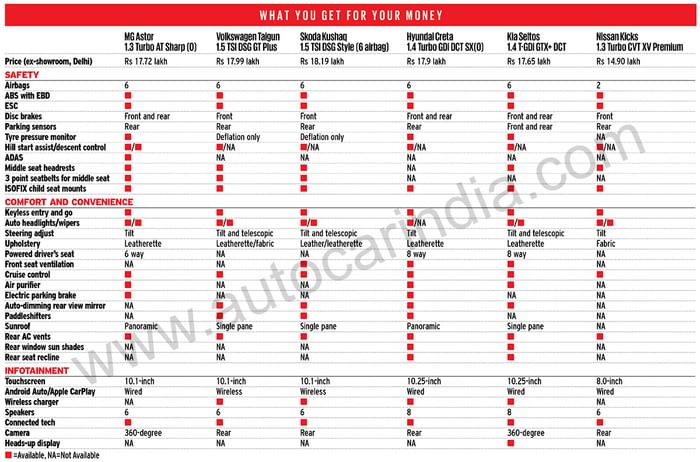
Different strokes
You’ve seen these models before so we’ll keep the bit on size and styling brief. It’s the Nissan Kicks that’s the longest, widest and tallest of the models here, though the MG Astor comes in a close second on size. But where the Kicks has the longest wheelbase in the segment, the Astor’s is the shortest. The Creta and Seltos are midsized within the midsized segment, while the Taigun and Kushaq have the smallest footprint. The VW’s and Skoda’s 2,651mm wheelbase is second only to the Kicks’ though.

Design is a subjective matter and everyone will have their own favourites. The MG Astor is well turned out and looks premium, though it’s more swoopy crossover than upright SUV. The last bit is true for the Nissan Kicks as well. It is the most distinctive in shape and that relatively high 210mm ground clearance also establishes it as the most outdoorsy of the six.
The Volkswagen Taigun and Skoda Kushaq do appear relatively small in the company of the other models, but they’re unmistakably European in look. Of the two, it’s the Taigun that has more flash, with a lot more chrome and that distinctive light bar at the back. The clean-cut Kushaq comes across as the more understated of the cousins.
The Creta and Seltos are not the largest on paper, but they do look the most substantial. The second-gen Creta is a sales hit, yes, but that split headlamp and split tail-lamp arrangement divides opinion even two years after launch. Flamboyant as the Kia Seltos is in its own way, it isn’t as dramatic as the Creta in look and many will like it for that.
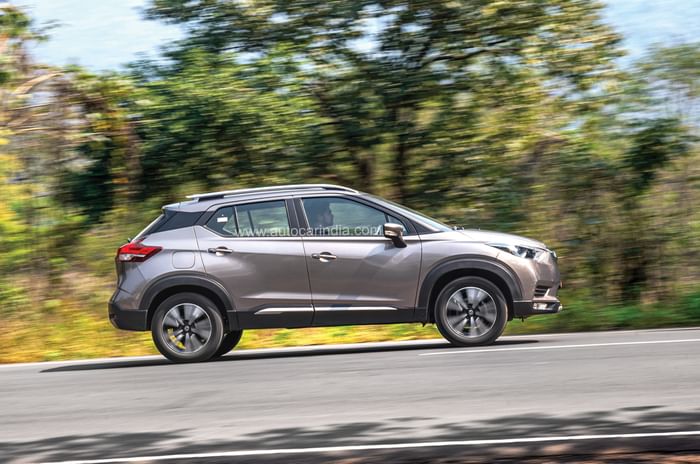
Looking inwards
Inside, the MG Astor immediately wows you for quality, with generous use of soft touch and padded materials on the dashboard. There’s a premium look and feel to the steering and buttons too, and though it might not look it in pictures, that optional Sangria Red cabin theme actually looks swell. The MG’s dash is neat, the 7.0-inch LCD cluster at the dials has stylish graphics and those up front will be comfy on the softly cushioned seats.
The Taigun experience starts with a characteristic reassuring sound on door shut, and you’ll like much of what you see inside. The dashboard is new-age VW, there’s red ambient lighting that adds a sense of occasion at night and though not full width, the digital instrument screen, with its three themes looks nice. Cabin quality is good, though you won’t find any soft touch materials inside. What’s a downer is that the obsessive German attention to detail is missing. The blanked-out buttons on the centre console are an eyesore and even the basic roof lining is very un-VW. Broader-framed occupants might find the front seats snug at the sides, but shoulder and thigh support are excellent.
You’ll find a lot of similar elements in the Kushaq, though the unique dashboard top does give the Skoda interior a different, more business-like vibe. The chrome detailing and dimpled effect on the dash look stylish, and the two-spoke steering with its chromed roller switches feels rich. However, all’s not perfect. The MID screen between the analogue instruments looks like it belongs to an older car, and again, the roof lining tells you where Skoda has cut costs. Elsewhere, you get the tough build, the plastics have a long lasting look to them, and even the large front seats are really supportive at the shoulders and legs, but aren’t quite generous in width.
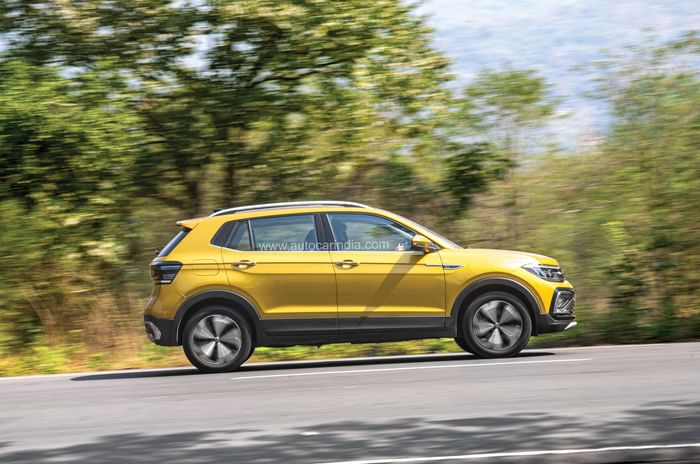
After spending time in the Astor, Taigun and Kushaq, the Creta gives the impression of being in a larger vehicle. Its cabin feels airier, you are also sat relatively high up on the well-cushioned front seats and because the dash cowl is low, you get the best view out. The Creta’s dashboard doesn’t break new ground for design, but is user-friendly. Where the Creta will leave you a bit wanting is in cabin quality, given Hyundai’s own high standards. There are many hard and shiny plastics that stand out in the Turbo variant’s all-black interior. Red details do help the look in daylight, while blue ambient lighting enhances the, well, ambience at night. Of the other things, the digital speedometer that changes theme with drive modes is neat and the large paddleshifters feel great to hold.
Like the Creta, the Seltos also feels bigger than the others on the inside. But that’s where the similarities end amongst the Korean cousins, when talking interiors. The Seltos has the more interesting dashboard that positions the touchscreen high up, but the large binnacle that extends to the instrument console could impact visibility for shorter drivers. The driver’s seat does offer plenty of adjustment, and that slightly firm cushioning is in keeping with the Kia’s sporty vibe. Do note, our GTX+ test car features a two-tone interior theme, but newer ones get an all-black theme. The Seltos does edge past the Creta with slightly better quality, including padded materials on the dash, and general attention to detail is better as well.
The Kicks’ cabin looks the most basic in this comparison, and there’s a reason for that. Nissan doesn’t sell the Kicks Turbo CVT in fully-loaded XV Premium Option form, which, among other things, packs in leatherette on the seats and dashboard. The Kicks’ dash is neat, but elements like the basic looking instruments don’t help the look of things inside. There are some ergonomic issues as well. The footwell is narrow, and the Kicks’ front seats sit too high even at their lowest position which means taller drivers will be looking down at the road rather than straight at it. Live with one and you’ll realise there’s a shortage of storage for small items in the Kicks as well. All other models offer ample places to keep odds and ends.
Feature film
Auto LED headlamps, push-button start, auto climate control, rear AC vents and cruise control are things you get on each of these models. All but the Creta also get rain-sensing wipers. The Kicks CVT that’s only sold in mid-spec just can’t match the others on frills, though. The Taigun and Kushaq do well with standard-fit steering tilt and telescopic adjust and also feature unique touch-operated controls for the climate system. Indents at the temperature and blower sliders means you don’t need to take your eyes off the road while making adjustments. There are some feature differences of note among the two cousins too. The Taigun gets digital dials, while the Kushaq gets you cooled front seats, though the system is quite noisy.

The Astor packs in a few more feel good features like a powered driver’s seat and an electronic parking brake. The AI assistant on the dash top that’s on call to act on commands for the sunroof and the like, as well as give you trivia from Wikipedia or even tell jokes, is a cute, if slightly gimmicky feature. For all its tech, the Astor misses out on things like an auto-dimming mirror and wireless charging. And while the Astor does pack in a 360-degree camera, the resolution isn’t great.
If you look at the big picture, it’s the usual suspects – Kia and Hyundai – that do the most to pamper those sat up front. For starters, both pack in powered driver’s seats and front seat ventilation. It’s the Seltos with the best cameras and is also unique with a handy head-up display. Where the Creta is superior is in its use of an electronic parking brake and the all-important panoramic sunroof, a feature that will make its way to the Seltos later this year.
In the area of infotainment systems, the Astor, Taigun, Kushaq, Creta and Seltos use touchscreens that measure just over 10 inches across, and all are nice enough to use. The Kicks has the smallest screen here that measures 8 inches. A useful inclusion on the Taigun and Kushaq is wireless Android Auto and Apple CarPlay. In terms of audio quality, the Creta and Seltos’ Bose system delivers the best sound. The Kushaq is the best of the rest in this department and goes one up on its cousin the Taigun with a subwoofer.
All these models get some level of connected tech so you can remotely keep an eye on your vehicle. An automated SOS alert to authorities in the event of an accident is an important safety feature.
Back to back
Shifting focus to the back, it’s the Creta and Seltos that are the roomiest for rear seat passengers. There’s a good deal of legroom and ample headroom even for tall passengers, and what makes all the difference is that their cabins are also wider than those of the other SUVs. Retractable window shades and backrests adjustable for angle also enhance comfort at the back. The Creta does score a few more points in this area though. It’s got the softer seat cushioning, the more supportive seat and those cushions for the headrests also feel quite nice to sink your head onto. But perhaps more than anything else, it’s the panoramic sunroof that gives the Creta the more special ambience.
A panoramic sunroof is a highlight on the Astor as well, and rear seat occupants will also find good kneeroom and nicely cushioned seats in the MG. The knees-up seating position isn’t best though, and the short seat squab also means thigh support is limited.
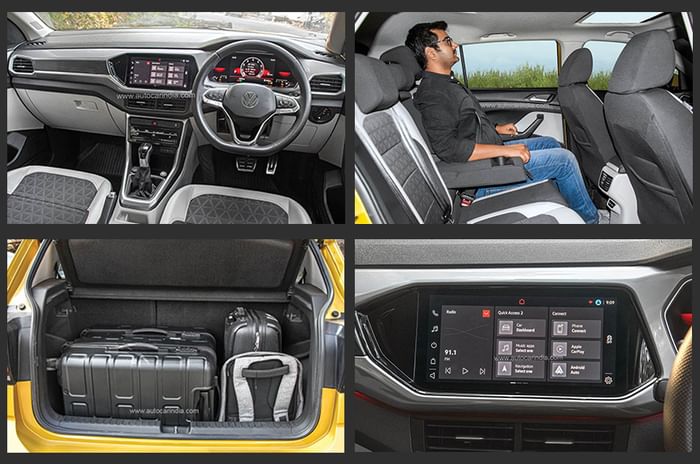
It’s the Taigun and Kushaq that have the most supportive rear seats. That relatively long 2,651mm wheelbase also comes into play, bringing with it an impressive amount of legroom. Even so, the Taigun and Kushaq feel the most compact. You are sat relatively close to your co-passenger, and while there’s enough headroom for six-footers, the roof hump (to accommodate the sunroof mechanism) takes away from the feeling of space inside. A point of difference here is that where the Taigun GT’s rear seat is finished in a combo of leatherette and fabric, the Kushaq’s is sheathed entirely in plusher leatherette.
The Nissan Kicks makes do with pretty basic fabric upholstery and is also the only one without a sunroof. Rear seat comfort is decent, but neither does the Kicks’ class-best wheelbase materialise into great legroom nor does that class-best width give it the most shoulder room.

If you plan to travel with a full house often, you should know that the Taigun and Kushaq are the tightest in terms of shoulder space. The Kicks and Astor are marginally better while the Creta and Seltos easily feel the most accommodating for three occupants at the back. That said, the Creta is the only one here without any form of a rear centre headrest. The Astor, Taigun and Kushaq also do well with a three-point seat belt for the middle passenger.
Bag and baggage
On airport runs and trips out of town, which one will take in the most luggage? The MG is on the back foot here, with the least space on offer. There’s room for two large suitcases, but not much else. The Creta and Seltos have the largest luggage capacity on paper – 433 litres each – but in practice, you’ll find that two large suitcases take up most of the space inside. On the contrary, the Taigun and Kushaq might offer just 385 litres but because of the way the luggage compartments are shaped, they can impressively hold two large suitcases, a cabin bag and a few soft bags. The Nissan Kicks, however, comes out on top in this area. Its 400-litre luggage compartment is widest, deepest and most accommodating. On the flipside, quite literally so, the Kicks is the only one without split rear seats.
The finer details
Before we dive in to the verdict, there are a few more critical points to touch upon. Numero uno, of course, is price. The Nissan Kicks CVT is the most affordable and by a massive margin at
Rs 14.9 lakh (ex-showroom, Delhi). Then again, you can only have this engine-gearbox in mid-spec XV Premium trim. The others in their fully-loaded avatars fall in the Rs 17.6 lakh-18.19 lakh range, with the Skoda Kushaq Style, recently upgraded with side and curtain airbags, being the priciest of the lot.
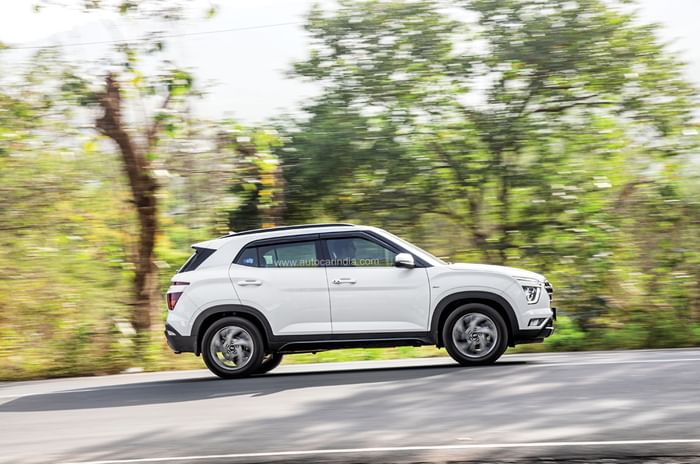
On the subject, there’s also the matter of waiting periods. You’ll be lucky to get ready delivery of any of these models. As per dealers in Delhi and Mumbai, for vehicles not in ready stock, the waiting period ranges from a minimum of 15 days for the MG Astor Turbo to as much as five months for a Hyundai Creta Turbo.
MG and Nissan haven’t revealed ARAI-tested fuel economy figures, but, of the rest, it’s the Taigun and Kushaq that boast the best official numbers. The VW and Skoda’s active cylinder deactivation tech (that shuts off two cylinders under light loads) plays a role in enhancing efficiency, and along with the Kicks, they’re the only ones to feature idle stop-start as well. It must be said though that turbo-petrols are very sensitive to driving style so the numbers can quickly tumble if you drive with a heavy foot. For these models, it’s safe to assume city economy in the 8-11kpl band, with the number improving to about 14-16kpl on highways.
Cost of service has become a battleground for manufacturers and the good news for buyers is that all of the models here can be had with maintenance packages with prices for four-year programmes in the Rs 19,000-25,000 band. It’s Volkswagen and Skoda that are most generous in their warranties with a standard 4 year/1,00,000km warranty. MG, Hyundai and Kia offer 3 year/unlimited km warranties as standard, while the Nissan Kicks comes with a 2 year/50,000km warranty. All manufacturers do offer optional extended warranty programs.
Personality match
So, finally, which is the one that’ll fit your needs best? The Nissan Kicks CVT sure has the numbers of most interest on its side. It’s got the lowest sticker price and most power. Even so, it’s not the performance pick, but the one to buy if you’re looking for a rugged crossover that can take a lot of abuse. Sadly, the Kicks doesn’t offer much by way of feel-good features, even for the money, which marks it down for many buyers.
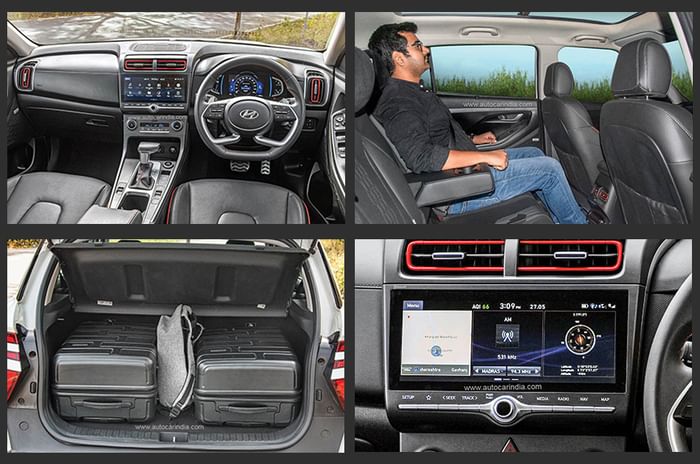
If driving engagement gets max weightage in your list of must haves, your choice should be between the Volkswagen Taigun and Skoda Kushaq. They’re easily the most entertaining to drive with their keen handling and exciting 1.5 TSI engines. They score well on other counts too, but those familiar with past products from either brand will find that the distinctive German-ness has been watered down on the made-for-India duo. There’s little between the two on features, but the Taigun’s digital instruments and added flash get it our vote.
The MG Astor is the most premium inside, and feels like a Euro-spec car. Interestingly, it’s the only one of the six that has an equivalent sold in Europe, namely the MG ZS. It backs this up with a comfortable experience on the move. The ADAS features are a USP in their own right and the keen pricing only helps the Astor’s case. However, the Astor isn’t sporty and that’s something which might not sit well with someone paying a premium for the more powerful Turbo version.
As a package, it’s the Creta and Seltos that feel the most complete. By virtue of being the roomiest, they make for great family cars and keen drivers will also find a good match in the turbocharged petrol variants that offer strong power and neat dynamics.
If you really break it down, the subtle differences between the two do add up to give them slightly different personalities. The Seltos comes across as the sportier, and more youthful pick. The Creta? It’s relatively more comfort-oriented. In the final analysis, it’s the Creta’s comfier ride, plusher rear seat and that panoramic sunroof, things which customers value hugely, that gives the Hyundai a small, but critical edge to help it just about nose past the Seltos.
| MG Astor vs Rivals: Verdict | ||||||
|---|---|---|---|---|---|---|
| MG Astor 1.3 Turbo AT Sharp (O) | Volkswagen Taigun 1.5 TSI DSG GT Plus | Skoda Kushaq 1.5 TSI DSG Style (6 airbag) | Hyundai Creta 1.4 Turbo GDi DCT SX(O) | Kia Seltos 1.4 T-GDi GTX+ DCT | Nissan Kicks 1.3 Turbo CVT XV Premium | |
| Price (ex-showroom, Delhi) | Rs 17.72 lakh | Rs 17.99 lakh | Rs 18.19 lakh | Rs 17.90 lakh | Rs 17.65 lakh | Rs 14.90 lakh |
| Rating | 8/10 | 8/10 | 8/10 | 9/10 [OUR CHOICE] | 9/10 | 7/10 |
| Verdict | Feels most premium and scores big on comfort. Not the one for keen drivers, though. | Great to drive, but is not perfect. VWs is missed. | Like Taigun, stands out for driving fun. Scores well, but not quite class best elsewhere. | Does the most for most types of buyers and makes for an SUV you can’t go wrong with. | Well-rounded package, but just about trails Creta on comfort. Is the sportier of the two cousins. | Easily the most rugged and wallet-friendly model, but can’t match others on comfort and features. |



















